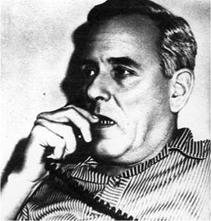INTRODUCING GEORGI BABAKIN
These setbacks led to a major shakeup in the moon programme. Korolev’s OKB-1 was now heavily overcommitted and the manned space programme was using up his full energies. Korolev approached the Lavochkin Design Bureau. This was, at first sight, a strange thing to do, for Lavochkin was an aircraft design bureau that had languished since the death of its founder, Semyon Lavochkin. This design bureau dated to 1937, being founded as Plant #301 by aviation designer Semyon Lavochkin. During the 1940s the plant made fighter aircraft and during the 1950s, cruise missiles. Plant # 301 was named the Lavochkin Design Bureau on the death of its founder in 1960. The deputy director then was Georgi Babakin but he had since gone to work for Korolev’s rival, Vladimir Chelomei.
Georgi Babakin is to become a central person in our story. Fifty-year-old Georgi Babakin was an unusual man, self-taught, with a healthy suspicion of formal education. Born in Moscow on 31st August 1914 (os), he developed an early passion for radio electronics, becoming senior radio technician with the Moscow Telephone Company in 1931. He was drafted into the Red Army’s Proletarian Infantry Division in 1936 where he was radio operator for six months before being dismissed for ill
|
Georgi Babakin |
health. He returned to school, where he completed his exams, joining the old Lavochkin Design Bureau during its plane-making days, rising to deputy chief designer. He eventually took a university degree in 1957 [2].
March 1965 saw a shakeup in the unmanned lunar programme in which the Ye-6 missions, as well as the interplanetary programme, left OKB-1. OKB-301 was effectively reconstructed, with its former deputy director Georgi Babakin returning as chief designer. Specifically, Korolev asked Georgi Babakin to ask him to take over the Ye-6 programme once the current OKB-1 production run was complete, but he knew that this would mean the entire set of programmes going to Lavochkin from then on. In April 1965, Sergei Korolev made his first and only visit to the Lavochkin Design Bureau. He met all the senior design staff, formally handed over the OKB-1 blueprints to them, made clear the heavy duty now incumbent upon them and warned them that he would take the projects back if they did not perform. Lavochkin’s experience of producing military aircraft stood to its advantage, for the company put much emphasis into ground testing and cleaning bugs out of the system beforehand.
Few people seem to have moved across from OKB-1 to Lavochkin. One who did was Oleg Ivanovsky. Another radio enthusiast, he was a cossack cavalryman during the war but was so badly wounded that at war’s end he was registered permanently disabled, facing a grim future without work or, more importantly, worker ration cards. An old friend managed to get him work in OKB-1 where his radio skills were quickly appreciated. Korolev gave him a key role in the radio instrumentation for Sputnik, the 1959 moon probes and then the Vostok, personally accompanying Yuri Gagarin to his cabin. When the new Lavochkin company was set up, Korolev found him a post as deputy chief designer, second only to Babakin [3].
At the same time, the Isayev bureau also improved the KTDU-5 engine system. A new version, called the KTDU-5A, was introduced. Using amine as fuel and nitric acid as oxidizer, it had a specific impulse of 278 sec, a thrust of 4,640 kg and a chamber pressure of 64 atmospheres. It was designed to burn twice – the first time for the mid-
course correction (up to 130m/sec) and then a second time for the landing (2,630 m/ sec) and had a total burn time of 43 sec [4]. The decision was also taken to upgrade the launcher and replace the unreliable 8K78 and block L by an improved version. The lower stages, the 8K78, were replaced by the 8K78M by the end of the year and the old block L by the new block MVL by 1968.











